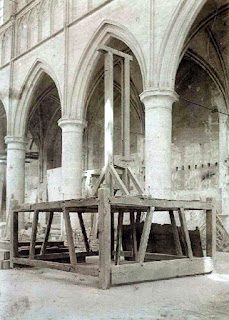"Terror is nothing other than justice, prompt, severe, inflexible" Maximilien Robespierre
The Guillotine http://www.historywiz.com/guillotine.htm
 Although the guillotine's fame dates from its extensive use during the Reign of Terror of the French Revolution, the first guillotine-like instrument was used as early as 1307. It may have been used earlier but the first solid evidence is its use in Ireland in 1307. It was not used much until it became the official instrument of execution for the French revolution. It was named for Dr. Louis Guillotin, who proposed that such a machine be used for official executions. It was actually constructed by others, though his name was forever associated with the machine.
Although the guillotine's fame dates from its extensive use during the Reign of Terror of the French Revolution, the first guillotine-like instrument was used as early as 1307. It may have been used earlier but the first solid evidence is its use in Ireland in 1307. It was not used much until it became the official instrument of execution for the French revolution. It was named for Dr. Louis Guillotin, who proposed that such a machine be used for official executions. It was actually constructed by others, though his name was forever associated with the machine. It was adopted because it was an egalitarian and humanitarian form of capital punishment. Previously the form of execution depended in part on a person's class. A noble might merit a quick blow from the headsman's axe (the custom was to offer a tip to the executioner to ensure a swift death), but if you were a commoner, you might suffer the torture of a drawing and quartering or some equally painful death.
The official executioner of the French Revolution, Charles-Louis Sanson, said on April 25, 1792:
Today the machine invented for the purpose of decapitating criminals sentenced to death will be put to work for the first time. Relative to the methods of execution practised heretofore, this machine has several advantages. It is less repugnant: no man's hands will be tainted with the blood of his fellow being, and the worst of the ordeal for the condemned man will be his own fear of death, a fear more painful to him than the stroke which deprives him of life.Some have speculated that these very virtues made it easier and more efficient to use it as an instrument to kill in large numbers. Would Maximilien Robespierre and his followers have been so quick to remove those citizens who failed to measure up in order to create his perfect "republic of virtue" if it were not so efficient and humane? It certainly would have been more difficult.
In spite of its efficiency, an execution by guillotine was still a sickening spectacle. When the head was severed, blood poured from the body as the heart continued to pump. When it was used frequently (as it was during the revolution), the stench from the place of execution was horrible. There is also some evidence to suggest that the head retained some life for a moment after the head was severed and so the death might not be as quick as has been supposed.
Although the guillotine is most closely associated with the French, the Nazis guillotined more people than were killed during the French Revolution. Hitler considered it a demeaning form of punishment and used it for political executions. 20,000 had a date with Madame la Guillotine in 1942 and 1943.
The last use of the guillotine was in 1977. Capital punishment has been abolished in France.






No comments:
Post a Comment